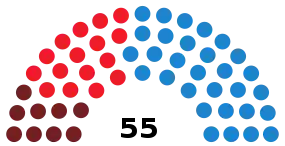1995 Madrid City Council election
The 1995 Madrid City Council election, also the 1995 Madrid municipal election, was held on Sunday, 28 May 1995, to elect the 5th City Council of the municipality of Madrid. All 55 seats in the City Council were up for election. The election was held simultaneously with regional elections in thirteen autonomous communities and local elections all throughout Spain.
| |||||||||||||||||||||||||||||||||||||||||
All 55 seats in the City Council of Madrid 28 seats needed for a majority | |||||||||||||||||||||||||||||||||||||||||
|---|---|---|---|---|---|---|---|---|---|---|---|---|---|---|---|---|---|---|---|---|---|---|---|---|---|---|---|---|---|---|---|---|---|---|---|---|---|---|---|---|---|
| Opinion polls | |||||||||||||||||||||||||||||||||||||||||
| Registered | 2,529,476 | ||||||||||||||||||||||||||||||||||||||||
| Turnout | 1,801,310 (71.2%) | ||||||||||||||||||||||||||||||||||||||||
| |||||||||||||||||||||||||||||||||||||||||
| |||||||||||||||||||||||||||||||||||||||||
People's Party (PP) incumbent José María Álvarez del Manzano again won an absolute majority of seats, improving his position relative to others as he obtained nearly 250,000 votes more than four years before. In contrast, the Spanish Socialist Workers' Party (PSOE) plummeted to one of its worst historical results, obtaining only 16 seats, to the benefit of United Left (IU) which scored its best result to date. Turnout was one of the highest in the history of the city, at 71.2%.
Electoral system
The City Council of Madrid (Spanish: Ayuntamiento de Madrid) was the top-tier administrative and governing body of the municipality of Madrid, composed of the mayor, the government council and the elected plenary assembly.[1] Elections to the local councils in Spain were fixed for the fourth Sunday of May every four years.[2]
Voting for the local assembly was on the basis of universal suffrage, which comprised all nationals over eighteen, registered in the municipality of Madrid and in full enjoyment of their political rights, as well as resident non-nationals whose country of origin allowed Spanish nationals to vote in their own elections by virtue of a treaty. Local councillors were elected using the D'Hondt method and a closed list proportional representation, with a threshold of five percent of valid votes—which included blank ballots—being applied in each local council. Parties not reaching the threshold were not taken into consideration for seat distribution.[1][2] Councillors were allocated to municipal councils based on the following scale:
| Population | Councillors |
|---|---|
| <250 | 5 |
| 251–1,000 | 7 |
| 1,001–2,000 | 9 |
| 2,001–5,000 | 11 |
| 5,001–10,000 | 13 |
| 10,001–20,000 | 17 |
| 20,001–50,000 | 21 |
| 50,001–100,000 | 25 |
| >100,001 | +1 per each 100,000 inhabitants or fraction +1 if total is an even number |
The mayor was indirectly elected by the plenary assembly. A legal clause required that mayoral candidates earned the vote of an absolute majority of councillors, or else the candidate of the most-voted party in the assembly was to be automatically appointed to the post. In the event of a tie, a toss-up would determine the appointee.[1]
The electoral law allowed for parties and federations registered in the interior ministry, coalitions and groupings of electors to present lists of candidates. Parties and federations intending to form a coalition ahead of an election were required to inform the relevant Electoral Commission within ten days of the election call, whereas groupings of electors needed to secure the signature of a determined amount of the electors registered in the municipality for which they were seeking election, disallowing electors from signing for more than one list of candidates. For the case of Madrid, as its population was over 1,000,001, at least 8,000 signatures were required.[2]
Opinion polls
The table below lists voting intention estimates in reverse chronological order, showing the most recent first and using the dates when the survey fieldwork was done, as opposed to the date of publication. Where the fieldwork dates are unknown, the date of publication is given instead. The highest percentage figure in each polling survey is displayed with its background shaded in the leading party's colour. If a tie ensues, this is applied to the figures with the highest percentages. The "Lead" column on the right shows the percentage-point difference between the parties with the highest percentages in a given poll. When available, seat projections are also displayed below the voting estimates in a smaller font. 28 seats were required for an absolute majority in the City Council of Madrid.
| Polling firm/Commissioner | Fieldwork date | Sample size | Turnout | Lead | |||
|---|---|---|---|---|---|---|---|
| 1995 municipal election | 28 May 1995 | N/A | 71.2 | 52.7 30 |
27.8 16 |
15.6 9 |
24.9 |
| Demoscopia/El País[p 1][p 2] | 10–15 May 1995 | ? | ? | 53.5 31 |
22.9 13 |
18.8 11 |
30.6 |
| CIS[p 3][p 4] | 24 Apr–10 May 1995 | 697 | 68.4 | 53.3 | 28.6 | 14.6 | 24.7 |
| Sigma Dos/El Mundo[p 2] | 3–7 May 1995 | ? | ? | 53.4 31 |
22.2 12/13 |
20.3 11/12 |
31.2 |
| Gruppo/ABC[p 5][p 6] | 9–14 Feb 1995 | 400 | ? | 51.8 30/31 |
21.6 12/13 |
21.4 12/13 |
30.2 |
| 1994 EP election[3] | 12 Jun 1994 | N/A | 61.4 | 53.9 32 |
22.4 13 |
17.6 10 |
31.5 |
| 1993 general election[4] | 6 Jun 1993 | N/A | 79.6 | 47.8 28 |
32.0 19 |
13.7 8 |
15.8 |
| 1991 municipal election | 26 May 1991 | N/A | 59.2 | 47.2 30 |
34.3 21 |
9.7 6 |
12.9 |
Results
 | ||||||
| Parties and coalitions | Popular vote | Seats | ||||
|---|---|---|---|---|---|---|
| Votes | % | ±pp | Total | +/− | ||
| People's Party (PP) | 945,634 | 52.71 | +5.48 | 30 | ±0 | |
| Spanish Socialist Workers' Party (PSOE) | 499,435 | 27.84 | –6.47 | 16 | –5 | |
| United Left (IU) | 279,090 | 15.56 | +5.84 | 9 | +3 | |
| The Greens–Green Group (LV–GV) | 13,013 | 0.73 | New | 0 | ±0 | |
| Platform of Independents of Spain (PIE) | 11,734 | 0.65 | New | 0 | ±0 | |
| The Alternative Greens (LVA)1 | 6,073 | 0.34 | +0.05 | 0 | ±0 | |
| Madrilenian Independent Regional Party (PRIM) | 2,228 | 0.12 | –0.06 | 0 | ±0 | |
| Humanist Platform (PH) | 1,450 | 0.08 | New | 0 | ±0 | |
| Spanish Phalanx of the CNSO (FE–JONS) | 1,244 | 0.07 | –0.06 | 0 | ±0 | |
| Revolutionary Workers' Party (POR) | 1,097 | 0.06 | ±0.00 | 0 | ±0 | |
| Workers' Revolutionary Party (PRT)2 | 622 | 0.03 | –0.17 | 0 | ±0 | |
| Independent Spanish Phalanx (FEI) | 615 | 0.03 | –0.01 | 0 | ±0 | |
| Coalition for a New Socialist Party (NPS)3 | 487 | 0.03 | –0.02 | 0 | ±0 | |
| Blank ballots | 31,467 | 1.75 | +0.54 | |||
| Total | 1,794,189 | 55 | –2 | |||
| Valid votes | 1,794,189 | 99.60 | –0.03 | |||
| Invalid votes | 7,121 | 0.40 | +0.03 | |||
| Votes cast / turnout | 1,801,310 | 71.21 | +12.06 | |||
| Abstentions | 728,166 | 28.79 | –12.06 | |||
| Registered voters | 2,529,476 | |||||
| Sources[5][6][7] | ||||||
References
- Opinion poll sources
- "El PSOE se hunde en las principales ciudades". El País (in Spanish). 21 May 1995.
- "El PP cree que la encuesta publicada por un diario madrileño tiene como objetivo alarmar a los electores e impulsar el voto de izquierda". ABC (in Spanish). 22 May 1995.
- "Preelectoral Municipales Madrid (Estudio nº 2159. Abril-Mayo 1995)". CIS (in Spanish). 10 May 1995.
- "Estudio CIS nº 2159. Ficha técnica" (PDF). CIS (in Spanish). 10 May 1995.
- "El Partido Popular reforzará su mayoría absoluta". ABC (in Spanish). 2 May 1995.
- "Encuesta de Gruppo para ABC/Resultados municipales". ABC (in Spanish). 6 May 1995.
- Other
- "Ley 7/1985, de 2 de abril, Reguladora de las Bases del Régimen Local". Law No. 7 of 2 April 1985. Boletín Oficial del Estado (in Spanish). Retrieved 30 June 2020.
- "Ley Orgánica 5/1985, de 19 de junio, del Régimen Electoral General". Organic Law No. 5 of 19 June 1985. Boletín Oficial del Estado (in Spanish). Retrieved 30 January 2020.
- "Electoral Results Consultation. European Parliament. June 1994. Madrid Municipality". Ministry of the Interior (in Spanish). Retrieved 12 November 2017.
- "Electoral Results Consultation. Congress. June 1993. Madrid Municipality". Ministry of the Interior (in Spanish). Retrieved 12 November 2017.
- "Local election results, 28 May 1995" (PDF). Central Electoral Commission (in Spanish). Retrieved 16 February 2018.
- "Electoral Results Consultation. Municipal. May 1995. Madrid Municipality". Ministry of the Interior (in Spanish). Retrieved 12 November 2017.
- "Elecciones Municipales en Madrid (1979 - 2015)". Historia Electoral.com (in Spanish). Retrieved 30 September 2017.
_Jos%C3%A9_Mar%C3%ADa_Aznar_recibe_al_alcalde_de_Madrid._Pool_Moncloa._19_de_junio_de_1996_(cropped).jpeg.webp)
_Felipe_Gonz%C3%A1lez_pasea_con_el_alcalde_de_Madrid_por_los_jardines_del_palacio_de_la_Moncloa._Pool_Moncloa._2_de_mayo_de_1986_(cropped)_(cropped).jpeg.webp)
